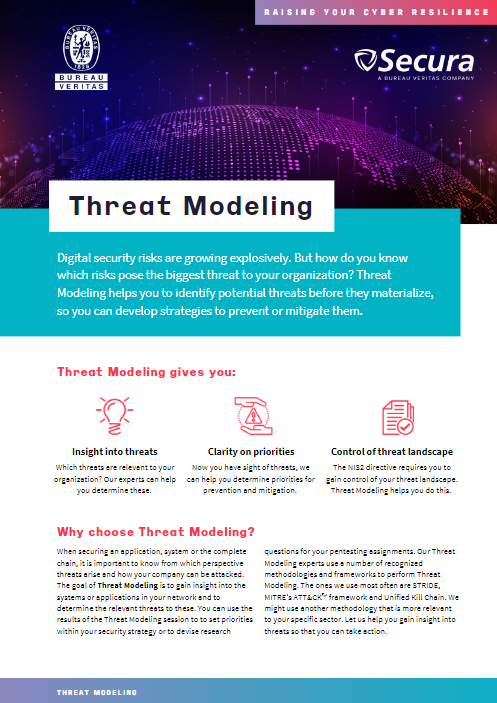Threat Modeling
Mapping potential cybersecurity risks in your systems.
> IT | PENTESTING & MORE > Threat Modeling
Identifying potential cybersecurity risks
As you know, digital security risks are growing explosively. But how do you know which risks pose the biggest threat to your organization? Secura’s Threat Modeling helps you to identify potential threats before they materialize. That way you can develop strategies to prevent or mitigate them.

An overview of potential cyber threats

Insight into the biggest cyber threats

Recommendations to prevent threats

Goal of Threat Modeling
When securing an application, system or the complete chain, it is important to know from which perspective threats arise and how a system can be attacked. The goal of this Threat Modeling session is to give you a complete picture of the threats and possible attack paths. With this information you can take concrete steps to improve your security.
The 3 steps of successful Threat Modeling
01
Preparation
During this phase, our experts discuss the scope of the exercise with you, to determine which staff should be present at the interactive session. We will also ask you for design documentation, if you have this, or other input.
02
Interactive session
This creative session is the heart of Threat Modeling. Using one of several recognized methodologies, the group will actively brainstorm relevant threats. This gives a complete picture of threats and possible attack vectors. Some methodologies, for instance STRIDE, create a so-called Data Flow Diagram or DFD as a first step which the group discusses in depth.
03
Reporting the findings
The Threat Modeling report details the scope, documents relevant threats and presents a high-level project plan to mitigate specific threats. Certain aspects will need to be analyzed in more detail, to see whether these potential threats can result in real-life risks. The report means you can take concrete next steps to improve your security.
Methodologies we use
Secura uses a number of recognized methodologies to perform Threat Modeling. These are the methodologies we use most often:
STRIDE
STRIDE is a well-known threat modeling technique. It focuses on six threat categories: Spoofing, Tampering, Repudiation, Information Disclosure, Denial of Service, and Elevation of Privilege. STRIDE was introduced by Microsoft and has gained popularity due to its effectiveness and simplicity.
MITRE’s ATT&CK™
The MITRE’s ATT&CK™ framework is a continuously evolving model used to understand the tactics and techniques employed by adversaries. The tactics and techniques detail specific actions previously executed by attackers, providing a comprehensive understanding of potential threat behaviors.
Unified Kill Chain
Cyber attacks are typically phased progressions towards strategic objectives. The Unified Kill Chain provides insight into the typical phases of attacks. The Unified Kill Chain combines and extends existing models such as Lockheed Martin's Cyber Kill Chain® and MITRE’s ATT&CK™. The model was developed by Paul Pols, Secura’s ransomware resilience lead.
Attack trees
Attack trees provide a hierarchical representation of attack paths, starting from a high-level goal and branching out into specific attack steps. Each step represents a potential attack vector or vulnerability. By constructing attack trees, you can assess the likelihood and impact of various attacks, prioritize mitigation efforts, and identify critical security controls.
Other methodologies
We might use other methodologies that are more relevant to a specific sector. For instance, we developed our own high-quality methodology for the automotive sector and product manufacturing. The specific methodology for your project will be determined during the preparation phase, in consultation with you.
Download Fact Sheet

Download Fact Sheet on our Threat Modeling Service
Threat Modeling helps you to identify potential threats before they materialize, so you can develop strategies to prevent or mitigate them.
DownloadContact me about Threat Modeling
Would you like to learn more about Threat Modeling? Please fill out the form below, and we will contact you within one business day.

Related Services
Design Review
Threat Modeling Training

In the Threat Modeling Training, you will learn how to get a broad picture of potential risks using the STRIDE methodology. This works both for existing systems and new designs.
Why choose Secura | Bureau Veritas
At Secura/Bureau Veritas, we are dedicated to being your trusted partner in cybersecurity. We go beyond quick fixes and isolated services. Our integrated approach makes sure that every aspect of your company or organization is cyber resilient, from your technology to your processes and your people.
Secura is the cybersecurity division of Bureau Veritas, specialized in testing, inspection and certification. Bureau Veritas was founded in 1828, has over 80.000 employees and is active in 140 countries.










